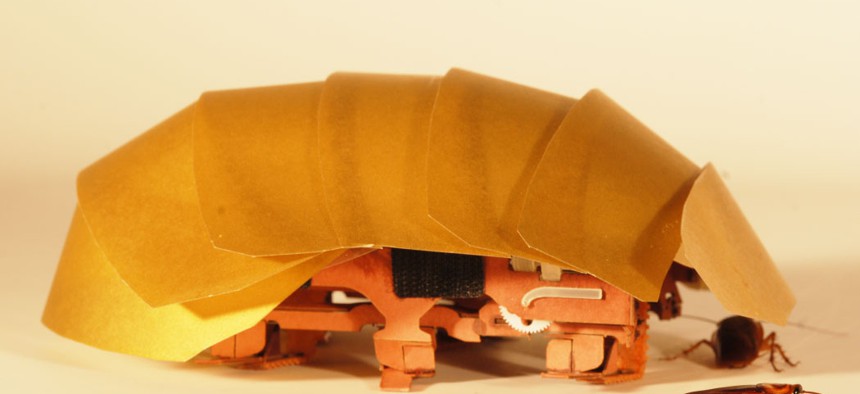Cockroaches inspire a new breed of disaster-site, battlefield robots
Researchers at UC Berkeley and ARL look to mimic the insect's flexibility, strength and speed.
Cockroaches may be one of the most universally reviled creatures on Earth but military researchers see real advantages in mimicking the insects while designing disaster-response robots.
Their flexible exoskeletons allow them to compress their frames down to about a quarter of their size to navigate (and escape from) tight spaces, but they can also stretch out on the run, scampering at high speeds. And they’re famously durable, able to easily withstand hundreds of times their own body weight (which brings to mind the old joke that only three things would survive nuclear explosion: catfish, cockroaches and Keith Richards.)
In short, robots modeled after cockroaches could go where humans couldn’t in a disaster area and survive conditions that would put a person at risk.
Researchers at the University of California-Berkeley, supported by the U.S. Army Research Laboratory, have come up with a prototype of such a robot, developing a palm-sized robot that can squeeze itself into confined spaces while crawling quickly through wreckage caused either by natural disaster or manmade explosions, according to an Army release.
The prototype is called CRAM, for compressible robot with articulated mechanisms, and researchers said they plan to test it in real-world conditions once they have come up with a sturdier version of their design.
The military has been working on disaster-response robotics for some time, most notably in DARPA’s Robotics Grand Challenge. But that contest concentrated on human-sized systems that could go into a disaster area and do what humans might otherwise do. The idea behind CRAM is to provide increased situational awareness to soldiers or first responders in complex, disrupted environments with robots that can see what the soldiers can’t.
"The research at UC Berkeley is exploring bio-inspired mobility and control methods that can be applied to future Army autonomous robotic systems," said Dr. Brett Piekarski, cooperative-agreement manager of ARL’s Micro Autonomous Systems and Technology, Collaborative Technology Alliance (MAST CTA). The alliance, consisting of researchers from the Army, industry and academia, is supporting UC Berkeley’s work.
That research into bio-inspired mobility isn’t limited to cockroaches, either. "Over the course of the program, they have performed research in many areas, from how insects can maneuver and transition over and through varying surfaces, to how lizards use their tails to maintain stability over rugged terrain or to maneuver rapidly, to bio-inspired self-righting technologies that have led to a joint project with ARL, and to the focus of the recent paper on how cockroaches maneuver through very small cracks,” Piekarski said.
Researchers also are looking for other improvements, such as better autonomy and improved collaboration, but a self-righting capability would be an important leap forward.
Chad Kessens, an ARL researcher working on the project, said soldiers have reported tip-overs to be a problem with other robotic systems (and was also a problem for some of thehumanoid robots in DARPA’s challenge). In addition to hindering operations, a tip-over could also prompt a soldier to put himself at risk to “rescue” the robot, as Kessens said one soldier he knows did.
“This is exactly what we do not want, and soldiers should not be tempted to risk themselves for a robot," he said. Maybe the fact that it looks like a cockroach can help with that.
NEXT STORY: Russia is widening the gap in EW





